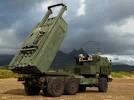Ammon News - AMMONNEWS - The Pentagon acknowledged Friday that ground-based rocket artillery fired from Jordan was used to strike targets in southern Syria last week, marking an expansion to U.S. ground operations in the war against the Islamic State.
Col. Steven Warren, a spokesman for the U.S.-led coalition in the region said that a small detachment of U.S. High Mobility Artillery Rocket Systems, or HIMARS, had fired a small salvo of rockets to support U.S. backed Syrian forces fighting near the tri-border region of Syria, Iraq and Jordan.
Jordan has long supported U.S. and coalition operations in the region, allowing the U.S. to use some bases to train Syrian rebels and providing their airfields for coalition air missions. Last week’s HIMARS strike, however, was the first time the Pentagon had acknowledged attacking the Islamic State directly from within Jordan’s borders.
According to U.S. strike assessments from that day the rockets hit a series of Islamic State fighting positions south of the Syrian city Palmyra.
Currently, HIMARS are also deployed in Iraq, specifically at two U.S. bases in al-Anbar province along with a detachment of self-propelled artillery. The rockets, up until last week’s strikes, had been used to support Iraqi troops fighting in and around Ramadi.
The rocket systems are manned by a crew of three and can fire three different type of rockets in pretty much any weather condition. There is 203mm unguided variant, 203mm guided variant, known as the GMLRS (pronounced Gimmlers), and a 603mm type called the ATACMS.
The strikes fired from Jordan used the GMLRS, the Pentagon said, which have a range of roughly 40 miles and are GPS-guided, allowing for precision strikes on stationary targets.
[Behind the scenes in the Marine Corps mission against the Islamic State]
Warren noted that the HIMARS were used because, for whatever reason, it made more sense to employ a land-based system rather an aircraft. This is likely due to the close proximity of the strike in relation to the Jordanian border. However, it is unclear where the targeting data for the rocket strike came from. Artillery systems, rocket or otherwise, usually rely on observers on the ground to accurately attack targets. In the case of a GMLRS strike, the GPS data could have been transmitted by drone or by advanced targeting software that provides precise coordinates based off satellite imagery.
*Washington Post
